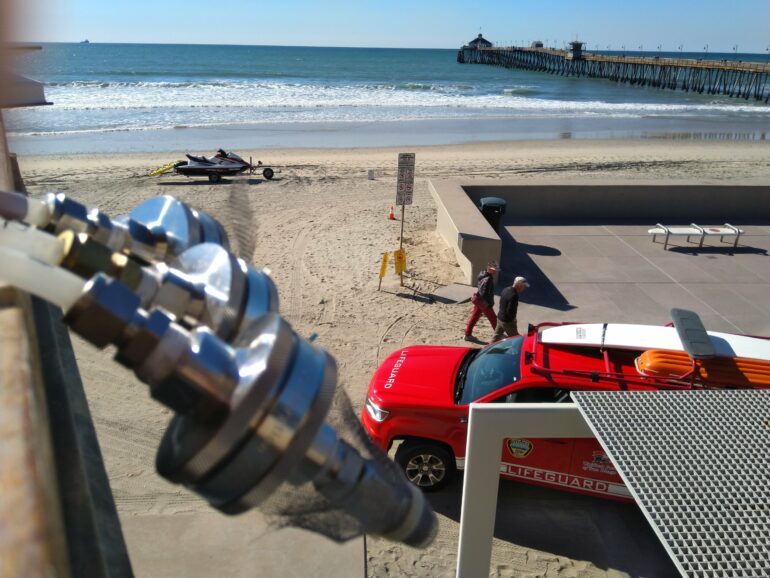Sitting on the beach, taking in the breeze, you might think the sea air is better for you than its inland equivalent. But researchers at the University of Houston have found that the air along the Gulf of Mexico coast in Texas can be more polluted due to its highly processed and acidic chemical components of particulate matter, which are microscopic solid or liquid particles in the air.
Shan Zhou, research assistant professor of atmospheric chemistry, led the new study published in Environmental Science & Technology.
“We found that ocean air was hazier and more polluted than the land breeze. The next question we had was why is it not clean? We concluded the microscopic particles known as particulate matter or aerosols from the Gulf of Mexico contain high concentrations of sulfate, which originates from anthropogenic (human-generated) shipping emissions. The emissions likely pump a lot of chemicals over the gulf and with a strong sea breeze, it brings that polluted air to land,” said Zhou, a faculty member in UH’s College of Natural Sciences and Mathematics who is the first and corresponding author of the study.
In addition to shipping emissions, the team points to chemical processing as additional cause of particulate matter pollution. They report meteorological conditions, including high sunlight intensity, temperature and enhanced air humidity provided a favorable environment for chemical reactions that formed secondary aerosols, which can be harmful to your lungs and heart, according to the EPA.
The research team used high-tech instrumentation that finds the chemical composition of the air in real time to conduct their study.
“I supervised the team of graduate students and researchers who deployed the aerosol mass spectrometer to our field site in Corpus Christi,” said co-corresponding author Rob Griffin, engineering professor at Roger Williams University. “The mass spectrometer tells us the mass of tiny particles in the atmosphere and gives us an indication of their constituents.”
The team spent several weeks collecting atmospheric data from Corpus Christi and San Antonio. The Corpus Christi metropolitan area in particular is understudied in atmospheric chemistry literature, compared to the Houston-Galveston and Dallas-Fort Worth regions. Further, only a handful of studies have investigated the composition and properties of particulate matter that originate in the Gulf of Mexico and travel into the region.
A perfect combination
Sulfate was the most abundant particulate component observed in the data from the Texas Gulf Coast air. Although this is similar to the atmospheric aerosol conditions of other marine locations globally, what set apart the Texas Gulf Coast was that its pollutant concentrations were much larger, by a factor of 3 to 70 times.
The authors write that this observation points to a strong anthropogenic influence on sulfur sources over the Gulf of Mexico. The Gulf is one of the busiest maritime transport regions with 11 of the 15 busiest water ports in the U.S. located along its shores, one of them being the Port of Corpus Christi. Large commercial vessels typically burn fuel oil and this can produce sulfur oxides.
The team found anthropogenic emissions over the Gulf of Mexico explain 78% of the total sulfate in the air from the Gulf.
Humidity, combined with pollutant chemicals, created the perfect conditions for the conversion of sulfur dioxide to sulfates; the latter is particularly effective in degrading visibility by scattering light before it reaches an observer. Water in this case acts as a solvent and catalyst that promotes the chemical reactions and produces sulfate pollution rapidly.
“The main difference I noticed in the coastal air pollution versus continental air pollution is that the coast pollution was very acidic,” Zhou said. “Acidic means it’s worse for your health compared to non-acidic particles.”
Looking ahead, Zhou aims to further investigate air pollutants over the sea. “Almost the entire state of Texas is potentially under oceanic flow throughout the year. How far can this sulfur pollution can come inland and how frequently can this happen?”
She hopes this study helps other researchers in their understanding of Gulf coast pollutants across the rest of the state.
More information:
Shan Zhou et al, Marine Submicron Aerosols from the Gulf of Mexico: Polluted and Acidic with Rapid Production of Sulfate and Organosulfates, Environmental Science & Technology (2023). DOI: 10.1021/acs.est.2c05469
Provided by
University of Houston
Citation:
Study finds sulfate pollution impacts Texas gulf coast air (2023, March 29)



